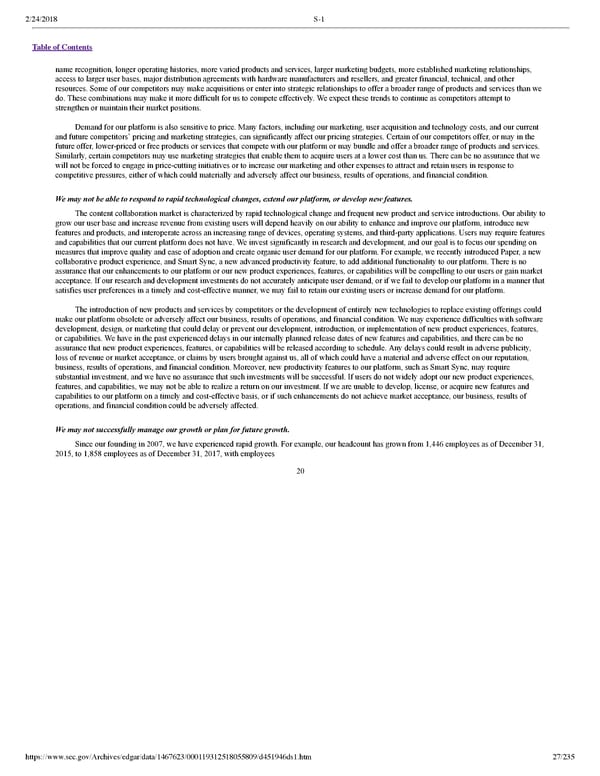2/24/2018 S-1 Table of Contents name recognition, longer operating histories, more varied products and services, larger marketing budgets, more established marketing relationships, access to larger user bases, major distribution agreements with hardware manufacturers and resellers, and greater financial, technical, and other resources. Some of our competitors may make acquisitions or enter into strategic relationships to offer a broader range of products and services than we do. These combinations may make it more difficult for us to compete effectively. We expect these trends to continue as competitors attempt to strengthen or maintain their market positions. Demand for our platform is also sensitive to price. Many factors, including our marketing, user acquisition and technology costs, and our current and future competitors’ pricing and marketing strategies, can significantly affect our pricing strategies. Certain of our competitors offer, or may in the future offer, lowerpriced or free products or services that compete with our platform or may bundle and offer a broader range of products and services. Similarly, certain competitors may use marketing strategies that enable them to acquire users at a lower cost than us. There can be no assurance that we will not be forced to engage in pricecutting initiatives or to increase our marketing and other expenses to attract and retain users in response to competitive pressures, either of which could materially and adversely affect our business, results of operations, and financial condition. We may not be able to respond to rapid technological changes, extend our platform, or develop new features. The content collaboration market is characterized by rapid technological change and frequent new product and service introductions. Our ability to grow our user base and increase revenue from existing users will depend heavily on our ability to enhance and improve our platform, introduce new features and products, and interoperate across an increasing range of devices, operating systems, and thirdparty applications. Users may require features and capabilities that our current platform does not have. We invest significantly in research and development, and our goal is to focus our spending on measures that improve quality and ease of adoption and create organic user demand for our platform. For example, we recently introduced Paper, a new collaborative product experience, and Smart Sync, a new advanced productivity feature, to add additional functionality to our platform. There is no assurance that our enhancements to our platform or our new product experiences, features, or capabilities will be compelling to our users or gain market acceptance. If our research and development investments do not accurately anticipate user demand, or if we fail to develop our platform in a manner that satisfies user preferences in a timely and costeffective manner, we may fail to retain our existing users or increase demand for our platform. The introduction of new products and services by competitors or the development of entirely new technologies to replace existing offerings could make our platform obsolete or adversely affect our business, results of operations, and financial condition. We may experience difficulties with software development, design, or marketing that could delay or prevent our development, introduction, or implementation of new product experiences, features, or capabilities. We have in the past experienced delays in our internally planned release dates of new features and capabilities, and there can be no assurance that new product experiences, features, or capabilities will be released according to schedule. Any delays could result in adverse publicity, loss of revenue or market acceptance, or claims by users brought against us, all of which could have a material and adverse effect on our reputation, business, results of operations, and financial condition. Moreover, new productivity features to our platform, such as Smart Sync, may require substantial investment, and we have no assurance that such investments will be successful. If users do not widely adopt our new product experiences, features, and capabilities, we may not be able to realize a return on our investment. If we are unable to develop, license, or acquire new features and capabilities to our platform on a timely and costeffective basis, or if such enhancements do not achieve market acceptance, our business, results of operations, and financial condition could be adversely affected. We may not successfully manage our growth or plan for future growth. Since our founding in 2007, we have experienced rapid growth. For example, our headcount has grown from 1,446 employees as of December 31, 2015, to 1,858 employees as of December 31, 2017, with employees 20 https://www.sec.gov/Archives/edgar/data/1467623/000119312518055809/d451946ds1.htm 27/235
 Dropbox S-1 | Interactive Prospectus Page 26 Page 28
Dropbox S-1 | Interactive Prospectus Page 26 Page 28